Best Knives for EDC:
A Complete Guide
By Trent Gander |
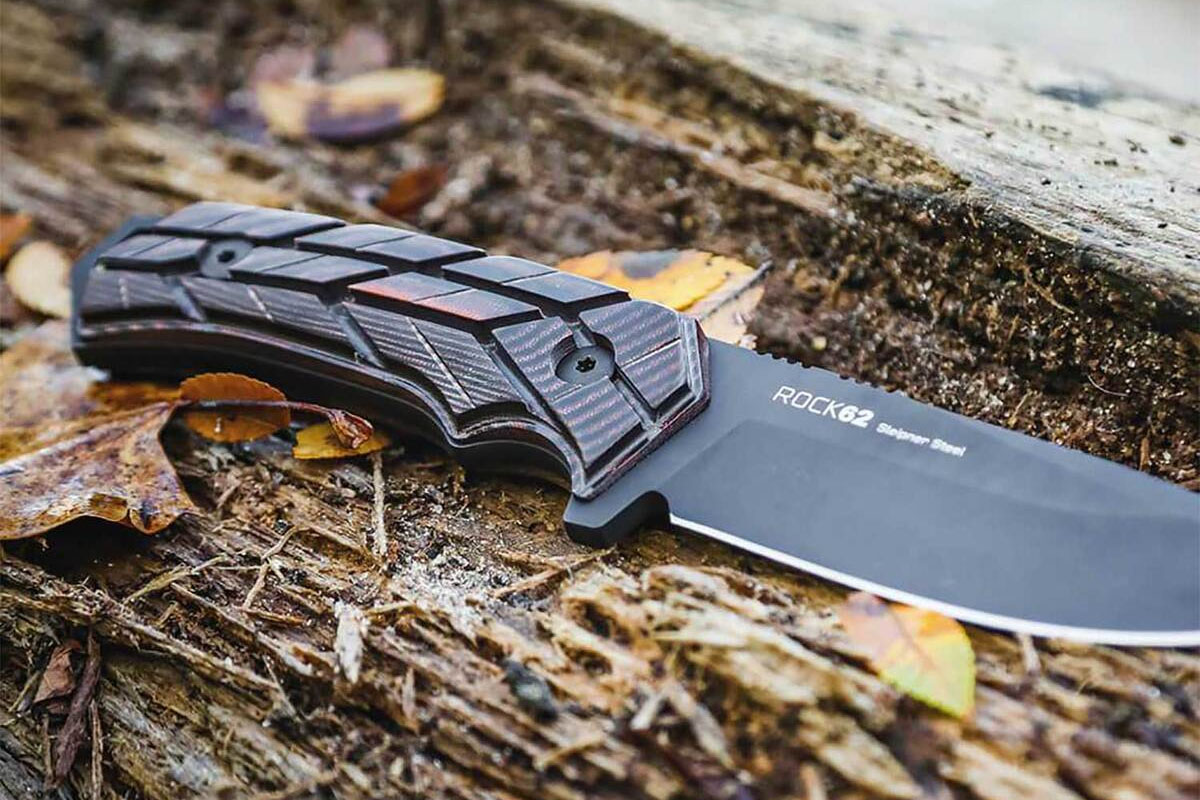
The term EDC or Every Day Carry is tossed around a lot online, especially when people talk about knife selection. But what is an EDC knife? What factors should you consider when selecting and EDC knife? And what are some of the best options out there?
We’re going to go over these questions and more to make sure you understand what you need for an EDC knife and what to look for within your budget.
Best Folding Knives
- Most Affordable Folder: Gerber Zilch
- Best Utility Folder: Spyderco Tenacious Plain Edge
- Most Legally Compliant Folder: Old Timer 340T Middleman
- Best Multi-Use Folder: Kershaw 1170 Method
- Best Defensive Folder: CRKT M16-03KS
Best Fixed Blade Knives
- Most Affordable Fixed Blade: Morakniv Pro S
- Best Utility Fixed Blade: Gerber StrongArm
- Most Ergonomic Fixed Blade: Ka-Bar TDI Personal Defense Knife
- Best Defensive Fixed Blade: Benchmade SOCP Dagger & Trainer
- Best Small Form Fixed Blade: CRKT Minamalist Bowie
What is an EDC Knife?
An EDC knife is a knife that you can easily carry on your person. An EDC knife is used for general utility or self-defense. Whether you decide to carry a folding knife, or a fixed blade knife will come down to local law and personal preference.
Folding knives are the most common EDC knives today. They easily fit into a pocket or bag and include older-style pocket knives, swiss army knives, and modern single blade folding knives. These styles of knives can feature belt/pocket clips. Older designs require two hands to open while modern designs opt for single hand opening methods.
Fixed blade knives are better for self-defense, less complex and usually more durable than folding knives. They require a sheath and are usually less compact than folding knives. This creates a problem when carrying a fixed blade knife since you have an overall larger object to deal with than a folding knife and it must always be sheathed.
Types of EDC

EDC blade shape, blade design, and method of deployment depends on whether the knife is used for utility or self-defense oriented. This creates two main types of EDC: utility knives and self-defense knives.
1. Utility Knives
| Blade Style |
|
| Blade Length |
|
| Serrations |
|
| Method of Opening |
|
|
Blade Style:
|
|
|
Blade Length:
|
|
|
Serrations:
|
|
|
Method of Opening:
|
Utility focused knives are the most common type of EDC knife. Since they are geared towards some form of utility, they offer the widest variation in blade styles. This provides consumers more leeway when it comes to selecting an EDC knife.
A “good knife” cuts or performs to our satisfaction. However, just because a knife can cut cardboard, doesn’t make it a great all-around utility knife. When you are selecting an EDC knife, think about the task you might need it to complete. What utility will the knife provide?
The harder you intend to use your knife, the more durable it needs to be. Some low cost knives are very durable but not as durable as more overbuilt designs. Overbuilt designs feature thicker, more resilient parts. This can be to overcome deficiencies in the materials used or to reinforce an already durable design. Some overbuilt designs come at a higher cost because of the reinforced parts.
Folding knives make great utility blades because they are easy to carry, come in a variety of blade designs, are usually quite affordable, and readily available.
Folding knives can also come with a belt or pocket clips which makes it easier for you to carry the knife while keeping it in a consistent place. This means the clip can’t be too tight or too loose otherwise drawing or carrying the knife becomes difficult.
A clip is more beneficial if it orients your hand to open it when you draw it. Clips set at the base of the handle tend to place the knife in a better orientation than clips by the folding mechanism, although this comes down to preference.
Serrations are an optional feature for most knives and come down to taste. A partially serrated blade allows for the knife to power through tough materials like rope or cordage. Non-serrated blades can cut through most material with ease when paired with proper technique and edge design. Many knives can’t receive these proper edge designs without a massive increase in cost which means these designs are found on higher priced knives.
2. Self-Defense Knives
| Blade Style |
|
| Blade Length |
|
| Serrations |
|
| Method of Opening |
|
|
Blade Style:
|
|
|
Blade Length:
|
|
|
Serrations:
|
|
|
Method of Opening:
|
Knives intended for self defense have more specific parameters than utility knives because of the unique challenges a self-defense knife must face.
Many utility knives can be pressed into use as a defensive knife, but purpose-built self-defense designs outperform them. While some folding knives are designed with defense in mind, fixed blades are usually better because they are easier to deploy and more durable.
Ideally, a fixed blade will be our primary choice for self-defense, but if we cannot have that, then a folding knife with a robust locking system is the next best option. Any self-defense knife must be easily deployed and simple to operate in a high stress situation.
Depending on your preferences, selecting a blade will come down to three basic designs: Slashing, Piercing, or Cut/Thrust blades.
1. Slashing Blades
Slashing or cutting blades usually feature wide blades and sometimes little to no point. These offer more defensive utility by creating space and covering larger areas when dealing with one or more opponents.
Cutting is a less-lethal defensive option since it can be physically and psychologically debilitating to your opponent, buying you enough time to escape, especially if the cuts are aimed at the hands or face.
2. Piercing Blades
Piercing blades have emphasized points and are designed to penetrate heavy clothing like denim or winter wear. Because of the emphasis on piercing, these types of blades are better for defending against single opponents. Piercing blades can reach important blood vessels or organs with less effort, resulting in them having a higher lethality than slashing blades.
3. Cut Thrust Blades
Cut and thrust blades combine slashing and piercing blades into one type of blade. These compromised designs give us more options in our defensive tool without locking us into one method of defense. However, they will never be a true 50/50 split in piercing and slashing performance.
Self-defense knives need to be secure in your grip and the handles need to facilitate this. For folding knives, the scales should help lock the blade into our hand but not to the extent it’s tearing up our hand and equipment. Fixed blade handles need to keep our hand from sliding up on the blade. They achieve this by featuring swells in the handle, finger grooves, or guards.
Gripping the knife in multiple ways can be beneficial in defensive scenarios and handles that allow for this are definitely preferred. This comes down to personal preference and certain knives can benefit from handles that emphasize a singular grip method.
Best EDC Knives
Personal preference and availability will also influence which knife is best for your EDC, here’s a list of recommended blades to give you an idea of what’s out there.
Most Affordable Folder: Gerber Zilch

The Gerber Zilch balances performance, cost, and function. Coming in at 3.1 inches in the blade, this knife is designed to take up as little room in your pocket as possible while still being a functional knife. It has two opening methods, a dual stud for ambidextrous use and a nail nick for more traditional two hand opening. The blade is a narrow drop point style offering both cutting and piercing ability.
Pros
- Good piercing and cutting potential
- Textured grip with finger knurl
- Affordable
Cons
- Narrow grip might impede knife handling
Blade Attributes & Specifications
| Blade Shape | Drop point |
| Blade Length | 3.1 inches |
| Serrations | None |
| Ambedextrous | Yes |
| Opening Style | Manual, dual barrel/stud & nail nick |
Best Utility Folder: Spyderco Tenacious Plain Edge
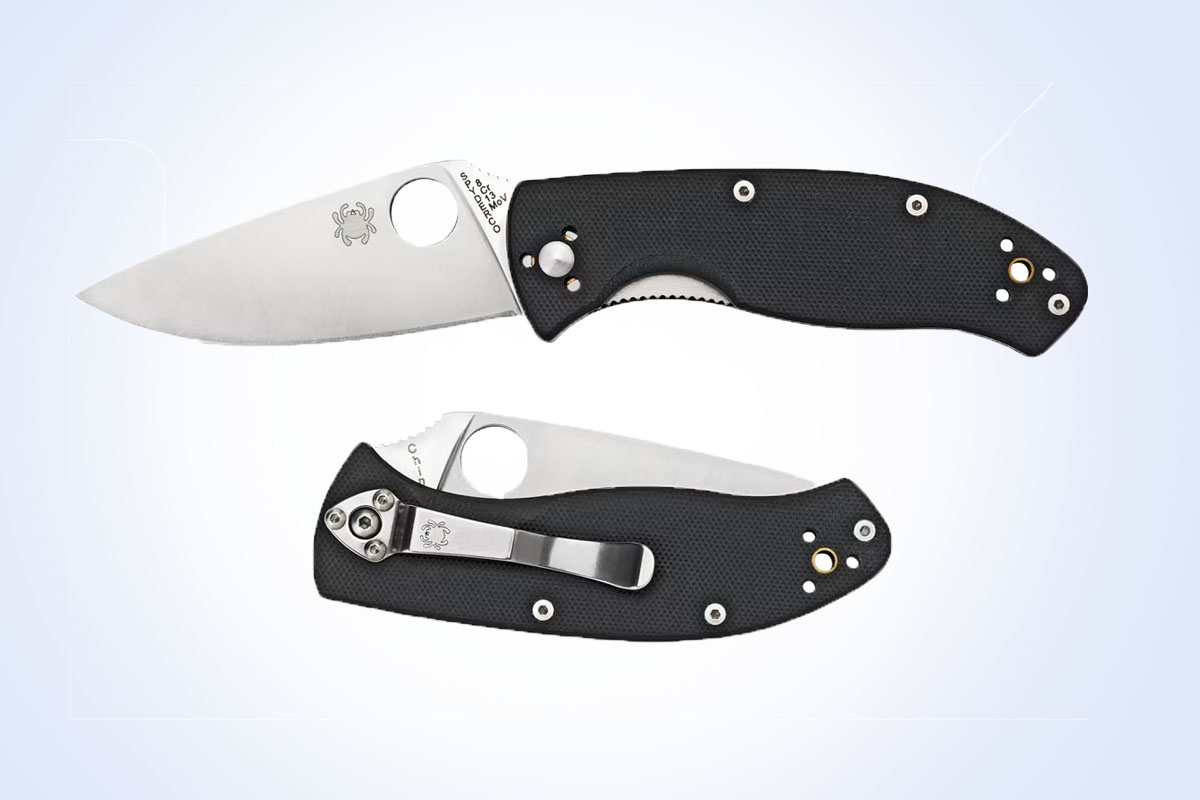
The Spyderco Tenacious is a very good utility orient blade. The thumb-hole opening method allows for full ambidextrous opening and creates fewer snag hazards than other designs.The drop point blade features a generous belly and wide edge. This makes it a great cutter, but takes away from the piercing potential. It also includes a customizable belt clip.
Pros
- Utility oriented blade
- Ambidextrous opening method
- Customizable belt clip orientation
Cons
- Expensive
Blade Attributes & Specifications
| Blade Shape | Drop point |
| Blade Length | 3.38 inches |
| Serrations | None |
| Ambedextrous | Yes |
| Opening Style | Manual, thumb-hole design |
Most Legally Compliant Folder: Old Timer 340T Middleman

This design by Old Timer features three different blade styles in a tiny package. It offers a pure utility knife that is legal in most locations.
Pros
- Legal in most locations
- Multiple blade options
- Good grip retention
Cons
- No belt clip
- No defensive potential
- Slow to open
Blade Attributes & Specifications
| Blade Shape | Clip point, sheeps foot, and spey |
| Blade Length | Longest blade 2.4 inches |
| Serrations | None |
| Ambedextrous | No |
| Opening Style | Nail nick |
Best Multi-Use Folder: Kershaw 1170 Method

The Kershaw 1170 Method offers an ergonomic handle with an extremely versatile blade design at an affordable price. The spear point tip is offset by a long belly. This leaves a lot of piercing potential while trying to provide good cutting capacity. The blade is deployed by an ambidextrous spur on the back of the handle.
Pros
- Good blade design for both utility and defense
- Well balanced for cutting and piercing tasks
- Good belt clip orientation
- KVT-ball bearing system for easy opening
Cons
- More expensive than other options
Blade Attributes & Specifications
| Blade Shape | Spear point |
| Blade Length | 3 inches |
| Serrations | None |
| Ambedextrous | Yes |
| Opening Style | Rear spur/flipper |
Best Defensive Folder: CRKT M16-03KS
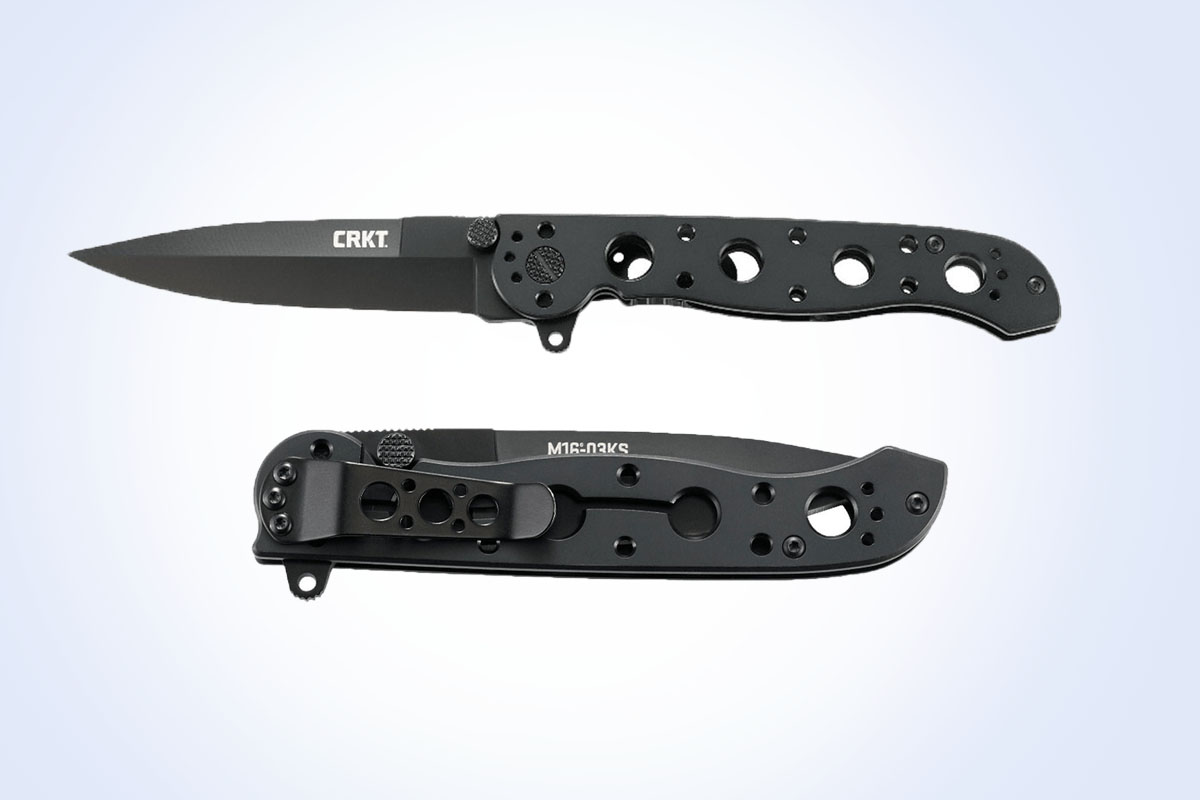
The M16-03KS by CRKT features the Carson Flipper Opening method and has dual thumb studs in addition to a rear facing spur. The 3.55 inch blade is a single-edged spear point with a narrow false edge on the rear of the blade. This gears it towards self-defense while retaining a small amount of utility.
Pros
- Light weight
- Good for self-defense
- Optimized for piercing
- Customizable belt clip orientation
Cons
- Little to no utility features
- Higher price than similar knife styles
Blade Attributes & Specifications
| Blade Shape | Spear point |
| Blade Length | 3.55 inches |
| Serrations | None |
| Ambedextrous | Yes |
| Opening Style | Dual thumb stud, Carson Flipper/spur |
Fixed Blades
Most Affordable Fixed Blade: Morakniv Pro S

The Pro S is a low cost bushcraft knife. It features a rubber coated handle that gives you a secure grip for great control over the stainless steel blade. While this knife is not a full-tang blade, it is still very durable with a clip point blade capable of a variety of cutting tasks.
Pros
- Durable overall design
- Clip point blade
- Large amount of utility
- Some self-defense potential
- Very affordable
Cons
- Non-ambidextrous sheath option
- Not extremely high quality fit and finish
Blade Attributes & Specifications
| Blade Shape | Clip point |
| Blade Length | 3.6 inches |
| Handle Material | TPE Rubber |
| Serrations | None |
| Sheath | Plastic |
Best Utility Fixed Blade: Gerber StrongArm
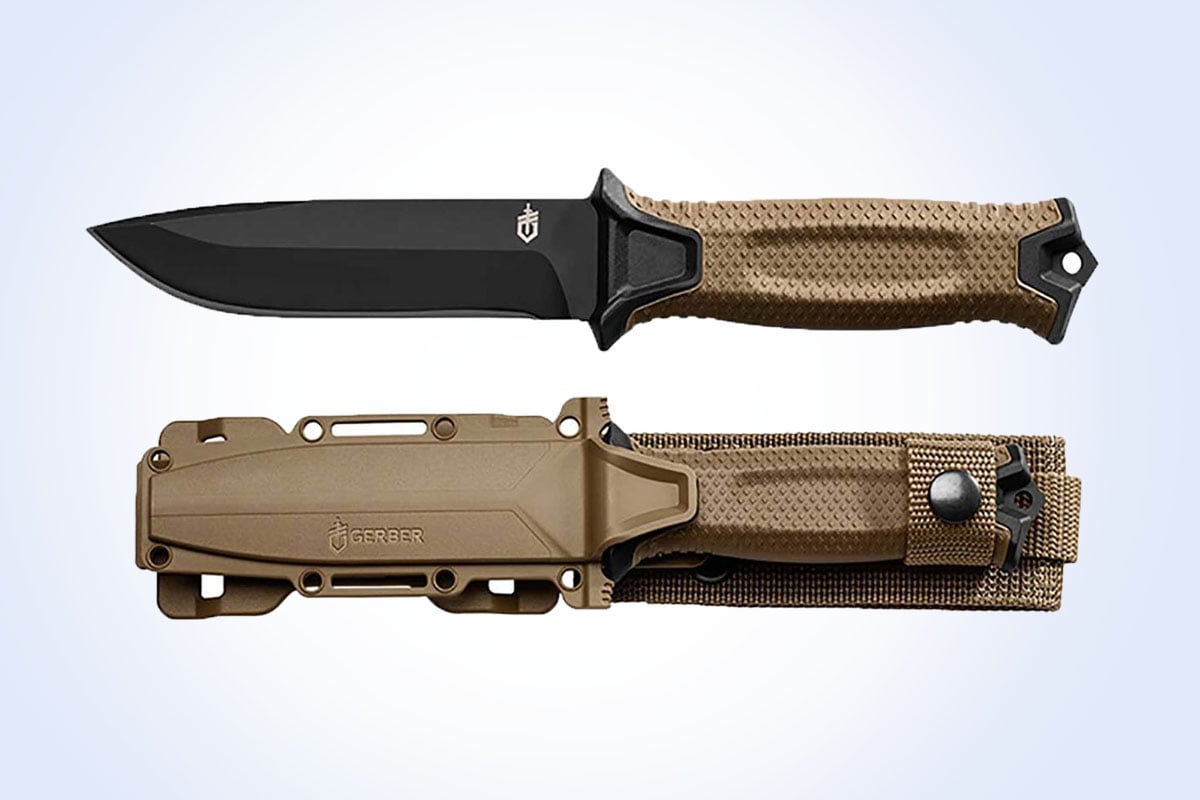
The Gerber StrongArm has a drop point style blade and features a plain edge, although other models do feature serrations. It is classified as a tactical knife, but functions well as a utility knife. The rubberized grip helps ensure you have control of the knife and the sheath is compatible with MOLLE, tactical belts, and normal belts. The sheath securely holds the knife and includes an additional retaining strap for extra retention.
Pros
- Good balance between utility and defense
- Glass breaker pommel adds utility
- Compatible with MOLLE equipment
Cons
- Large overall size w/sheath
- More expensive than other options
Blade Attributes & Specifications
| Blade Shape | Drop point |
| Blade Length | 4.8 inches |
| Handle Material | Glass filled Nylon w/Diamond Rubber Overmold |
| Serrations | Model Dependent |
| Sheath | Plastic/cordura, MOLLE compatible |
Most Ergonomic Fixed Blade: Ka-Bar TDI Personal Defense Knife
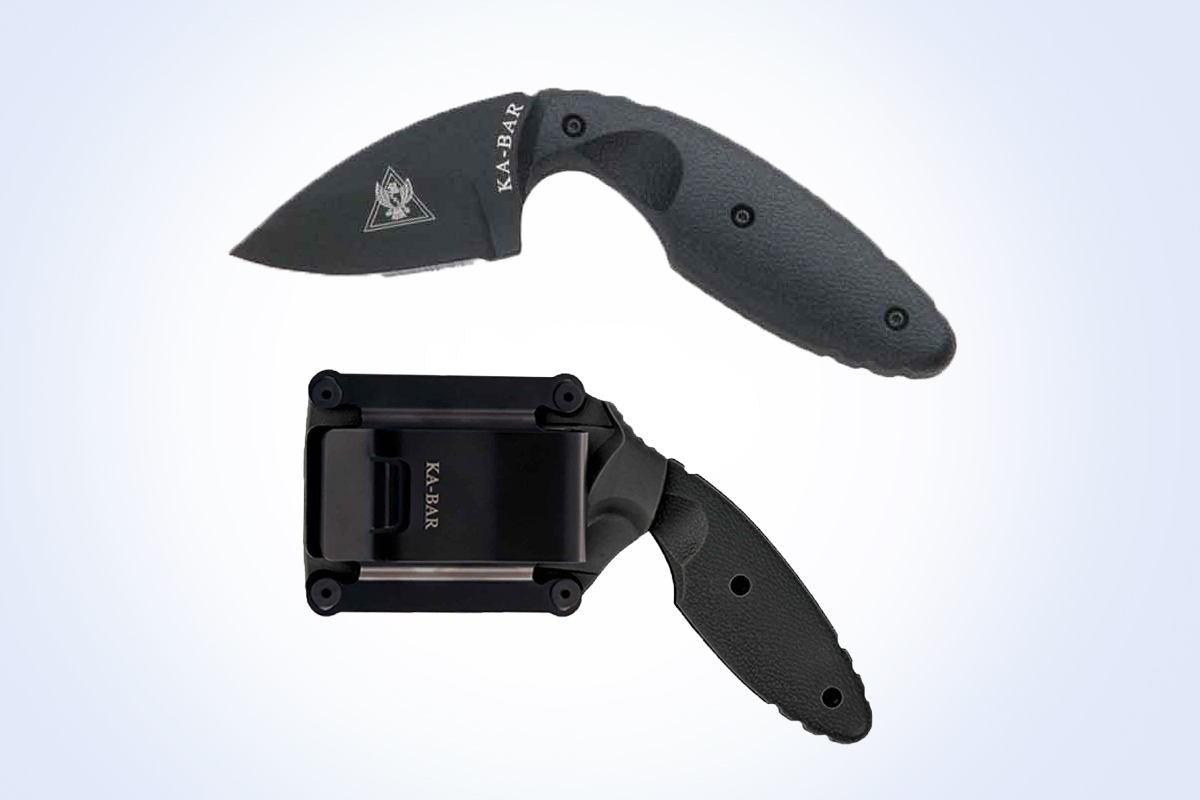
This defensive knife from Ka-Bar is a great alternative to more expensive designs. This smaller blade option is designed as a close-in defensive tool and is easier to carry than larger options. The full handle allows you to easily hold and control the knife while the drop point allows for a little utility.
Pros
- Great self-defense option
- Good handle orientation
- Piercing point with slashing capability
Cons
- Little to no utility
- Sheath is easily angled for best user experience
Blade Attributes & Specifications
| Blade Shape | Drop point |
| Blade Length | 1.25 inches |
| Handle Material | Zytel |
| Serrations | Model dependent |
| Sheath | Plastic w/belt clip |
Best Defensive Fixed Blade: Benchmade SOCP Dagger and Trainer

This Benchmade dagger is a great self-defense blade that specializes in piercing. The design allows for very close in situations while providing a secure grip. But the double-edged blade means it is restricted in some areas. Additionally, the SOCP is extremely expensive when compared to other blade designs.
Pros
- Primarily fighting oriented
- Ring helps with grip, draw, and extending reach
Cons
- Double edged design limits its carry locations
- Sheath can cause discomfort while worn
- Expensive, especially with an aluminum trainer
Blade Attributes & Specifications
| Blade Shape | Dagger |
| Blade Length | 3.22 inches |
| Handle Material | 440C skeletonized steel |
| Serrations | Model dependent |
| Sheath | Injection molded plastic |
Best Small Form Fixed Blade: CRKT Minimalist Bowie
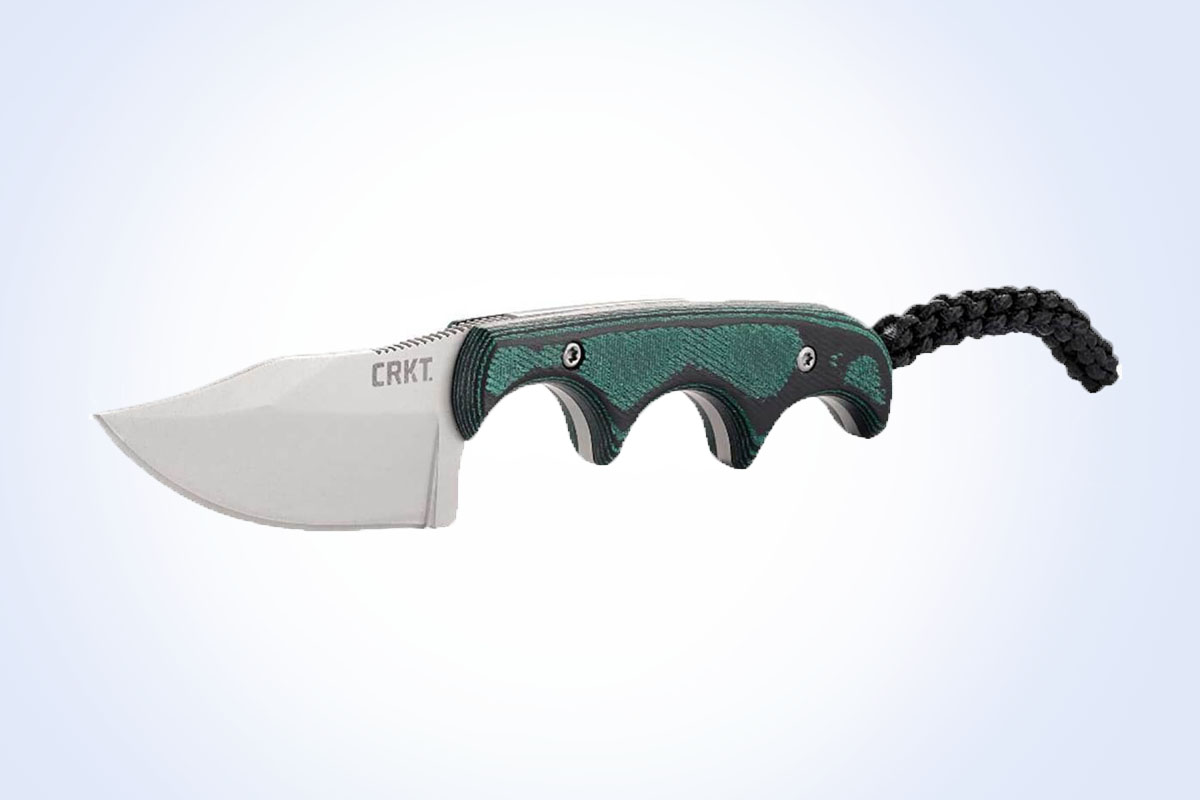
The CRKT Minimalist Bowie is a great option if you want to balance utility and self-defense. This design is better than the Ka-Bar TDI in terms of cutting and piercing ability and has a more versatile sheath design.
Pros
- Good at cutting and piercing
- Balances defense and utility well
- Lightweight
- Easily carried in multiple ways
Cons
- Finger grooves only allow for one grip method
Blade Attributes & Specifications
| Blade Shape | Clip point |
| Blade Length | 2.13 inches |
| Handle Material | Polished Resin Infused Fiber |
| Serrations | None |
| Sheath | Thermoplastic |